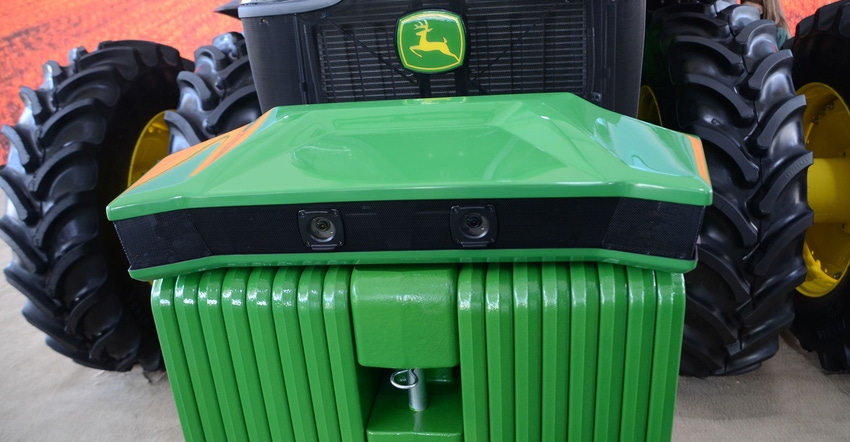June 17, 2022

Several years ago, John Deere changed its “deer” logo to one showing the animal leaping up instead of jumping down or over. That upward ambition was a key message during a conference for industry analysts, dubbed “Leap Ambitions.” In late May, company leadership shared insights at the event, which was broadcast for media and the public.
The more than two-hour conference was a major data dump on a range of technologies and business issues the company has in store. As CEO John May noted, the company’s motto is, “We run so life can leap forward,” adding that the company was focusing on technology that underpins that purpose and would “help the world do more with less.”
And there’s plenty of opportunity ahead in helping customers succeed. Company leadership quantified the market value as $150 billion, which will provide value for investors.
Helping set the stage, May shared how the fast-changing world is bringing new complexity to agriculture. “The days of abundant resources in farming inputs is over,” he said. “Labor, fertilizer, crop protection inputs are more scarce and increasing in cost; weather is more volatile; and governments are bringing more regulation.”
With that in mind, the company is focused on helping farmers do more with less and points to two new technologies launched in the past year to prove it. From See & Spray Ultimate, which can cut pesticide use by up to 80% depending on weed pressure, to the new Autonomous 8R tractor announced in January, which will free up labor. While that second tech starts with tillage, the meeting promised more capability ahead.
Building on tech base
While the new high-tech products show where Deere is headed, it starts with sense and act technology that Deanna Kovar explained will help farmers drive better profit and sustainability. Kovar is vice president of production and precision ag production systems.
She noted that farmers are managing fields by zones within each field, and with a new level of sense and act technologies it will bring “plant level at scale with ease in real time,” she said. Noting that there are about 4 trillion corn plants in fields each season, the aim is to manage at the plant level with the new tools.
The sense and act technology powers more than See & Spray Ultimate and the autonomous 8R. “Customers are adopting more intelligence and automation tools like Combine Advisor today,” she noted.
Jorge Heraud, vice president of automation, elaborated on this, noting that John Deere is expanding its machine-learning platform. Information gathered from Combine Advisor, See & Spray Ultimate and the autonomous tractor can be pulled into John Deere (with the farmer’s permission) to be analyzed. Machine learning works better as you feed the system more imagery, inputs and information.
“Our platform allows us to accelerate machine learning,” he said. “We can search, curate, label and deploy models back to the machine [to make it more precise].”
One factor Deere brings to the table that other players in tech don’t, Heraud said, is scale. “Using all the hardware already installed in these machines, we have a larger installed base and can keep improving them,” he said.
The ability to upgrade operating software on machines is one solid benefit of the new technology. John Deere has installed telemetry technology in its machines since 2012, allowing for upgrades.
Changing income stream
During the conference, there was discussion of another change ahead. The original model for the farm equipment market was that a company designs and builds a machine and then sells it to a buyer. That purchase is the key transaction between company and farmer. Parts support provides some added income, but the base was that new equipment sale. That could be changing.
During the presentation, Ryan Campbell, chief financial officer, shared that the company believes that no industry is more ready for “positive disruption for tech than ag,” he said. The key is the creation of a system of solutions working seamlessly together for tangible outcomes for customers. The aim is new value creation moving from monetized products at the point of sale to selling through a software-as-a-service model.
“We would increase adoption [of new technology] across the installed base, have a lower upfront cost and receive more functionality over time,” he said. It’s a move toward continuous improvement of an existing machine.
For example, the development of the autonomous technology is essentially built on automation already in most tractors. The idea would be that a base 8R would come equipped with the cameras and be ready to be autonomous, but not have that software turned on unless the farmer needs it.
Adds Josh Jepsen, deputy financial officer, said, “It will increase the value of a machine over its lifetime and increase shareholder value.”
The aim is to create a more steady stream income through what would essentially be a subscription model. A tractor will be a tractor but come “ready” to be autonomous at different levels. A farmer would buy access to the tool that might allow autonomous tillage, but later perhaps a subscription for planting and another for running a sprayer.
Jepsen said it will take a few years to build a base, but by 2030, most equipment would come ready with tech on board just waiting for the user to subscribe to a specific service.
The John Deere Tech Stack with its sense and act capability offers the promise of enhanced productivity based on specific farmer needs in the future. The software-as-a-service model is seeing more interest across the industry. This development bears watching, but future Deere buyers may find their machine ready to leap ahead, as needed.
About the Author(s)
You May Also Like






